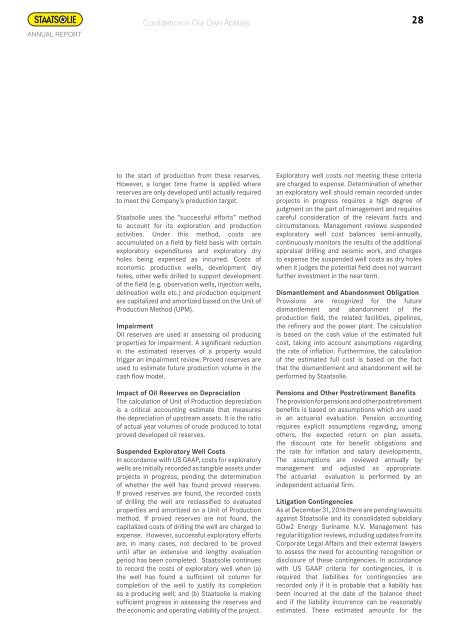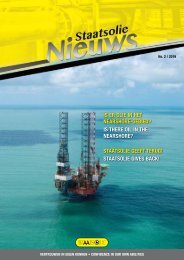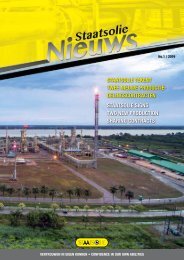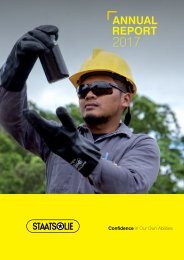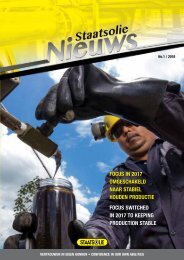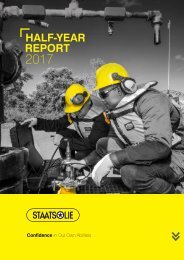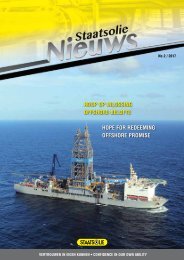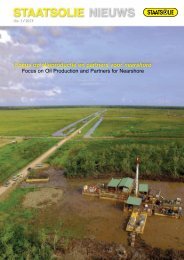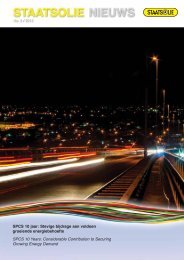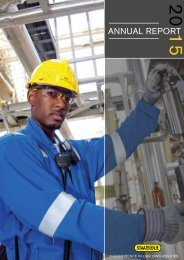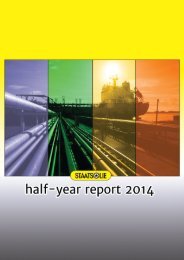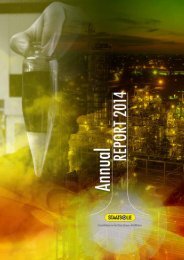annual_repport_staatsolie_2016_lr
Create successful ePaper yourself
Turn your PDF publications into a flip-book with our unique Google optimized e-Paper software.
Annual REPORT<br />
Confidence in Our Own Abilities<br />
28<br />
to the start of production from these reserves.<br />
However, a longer time frame is applied where<br />
reserves are only developed until actually required<br />
to meet the Company’s production target.<br />
Staatsolie uses the “successful efforts” method<br />
to account for its exploration and production<br />
activities. Under this method, costs are<br />
accumulated on a field by field basis with certain<br />
exploratory expenditures and exploratory dry<br />
holes being expensed as incurred. Costs of<br />
economic productive wells, development dry<br />
holes, other wells drilled to support development<br />
of the field (e.g. observation wells, injection wells,<br />
delineation wells etc.) and production equipment<br />
are capitalized and amortized based on the Unit of<br />
Production Method (UPM).<br />
Impairment<br />
Oil reserves are used in assessing oil producing<br />
properties for impairment. A significant reduction<br />
in the estimated reserves of a property would<br />
trigger an impairment review. Proved reserves are<br />
used to estimate future production volume in the<br />
cash flow model.<br />
Impact of Oil Reserves on Depreciation<br />
The calculation of Unit of Production depreciation<br />
is a critical accounting estimate that measures<br />
the depreciation of upstream assets. It is the ratio<br />
of actual year volumes of crude produced to total<br />
proved developed oil reserves.<br />
Suspended Exploratory Well Costs<br />
In accordance with US GAAP, costs for exploratory<br />
wells are initially recorded as tangible assets under<br />
projects in progress, pending the determination<br />
of whether the well has found proved reserves.<br />
If proved reserves are found, the recorded costs<br />
of drilling the well are reclassified to evaluated<br />
properties and amortized on a Unit of Production<br />
method. If proved reserves are not found, the<br />
capitalized costs of drilling the well are charged to<br />
expense. However, successful exploratory efforts<br />
are, in many cases, not declared to be proved<br />
until after an extensive and lengthy evaluation<br />
period has been completed. Staatsolie continues<br />
to record the costs of exploratory well when (a)<br />
the well has found a sufficient oil column for<br />
completion of the well to justify its completion<br />
as a producing well; and (b) Staatsolie is making<br />
sufficient progress in assessing the reserves and<br />
the economic and operating viability of the project.<br />
1<br />
Exploratory well costs not meeting these criteria<br />
are charged to expense. Determination of whether<br />
an exploratory well should remain recorded under<br />
projects in progress requires a high degree of<br />
judgment on the part of management and requires<br />
careful consideration of the relevant facts and<br />
circumstances. Management reviews suspended<br />
exploratory well cost balances semi‐<strong>annual</strong>ly,<br />
continuously monitors the results of the additional<br />
appraisal drilling and seismic work, and charges<br />
to expense the suspended well costs as dry holes<br />
when it judges the potential field does not warrant<br />
further investment in the near term.<br />
Dismantlement and Abandonment Obligation<br />
Provisions are recognized for the future<br />
dismantlement and abandonment of the<br />
production field, the related facilities, pipelines,<br />
the refinery and the power plant. The calculation<br />
is based on the cash value of the estimated full<br />
cost, taking into account assumptions regarding<br />
the rate of inflation. Furthermore, the calculation<br />
of the estimated full cost is based on the fact<br />
that the dismantlement and abandonment will be<br />
performed by Staatsolie.<br />
Pensions and Other Postretirement Benefits<br />
The provision for pensions and other postretirement<br />
benefits is based on assumptions which are used<br />
in an actuarial evaluation. Pension accounting<br />
requires explicit assumptions regarding, among<br />
others, the expected return on plan assets,<br />
the discount rate for benefit obligations and<br />
the rate for inflation and salary developments.<br />
The assumptions are reviewed <strong>annual</strong>ly by<br />
management and adjusted as appropriate.<br />
The actuarial evaluation is performed by an<br />
independent actuarial firm.<br />
Litigation Contingencies<br />
As at December 31, <strong>2016</strong> there are pending lawsuits<br />
against Staatsolie and its consolidated subsidiary<br />
GOw2 Energy Suriname N.V. Management has<br />
regular litigation reviews, including updates from its<br />
Corporate Legal Affairs and their external lawyers<br />
to assess the need for accounting recognition or<br />
disclosure of these contingencies. In accordance<br />
with US GAAP criteria for contingencies, it is<br />
required that liabilities for contingencies are<br />
recorded only if it is probable that a liability has<br />
been incurred at the date of the balance sheet<br />
and if the liability incurrence can be reasonably<br />
estimated. These estimated amounts for the<br />
1


